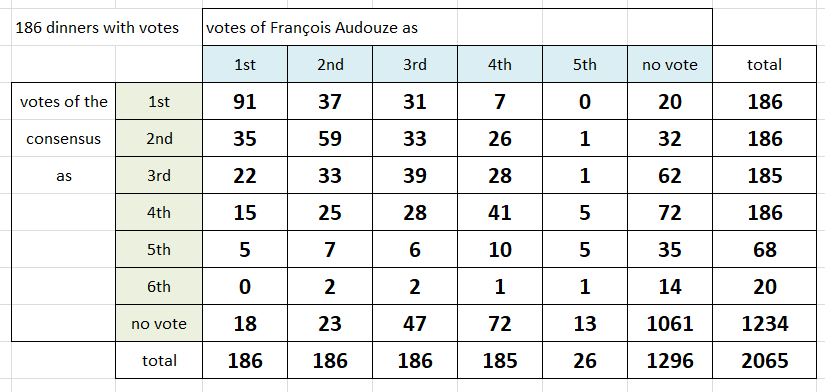Have we the same palates? I have the chance to have collected for many of my dinners the votes for the best wines for everyone. We are generally 10 to 12 diners and we vote for the four or five best wines of the dinner.
Of the 226 dinners, there were 186 dinners where there were votes, concerning 2065 wines or 11.1 wines per meal. I have kept the votes of the participants and for each dinner I have the vote of consensus and my vote. We voted generally for four wines and 26 dinners had five votes. For consensus I sometimes calculated more votes than the number of wines voted by each person.

The table shows the distribution of votes between my vote and the vote of consensus. This sheet reads as follows: out of 186 wines that I have classified in 2, there are 37 that are first for the consensus, 59 voted second also by the consensus and 23 that do not appear in the vote of the consensus.
Thus, only 91 wines out of 186 dinners are at the same time first for me and for the consensus, ie only half. If we consider the wines that are in the first three for me and are in the top three of the consensus, there are 380 out of 558 possible wines, which makes 68% of consistency between the consensus and me.
The wines of the 186 dinners have an average age of 51 years. The 1061 wines that are neither in my vote nor in the consensus vote have an average age of 44.3 years whereas the 91 wines which are first for the consensus and for me are 73.3 years old. In my dinners, the oldest wines are the most prized.
If I consider the wines of Romanée Conti, there were 113 in 186 dinners. 67 are in my vote and 87 are in the consensus vote. And if 23 are first for me, 30 are first for consensus. For many guests, the novelty effect of Romanée Conti’s discovery plays. It is the same for Yquem, present 122 times in these dinners, 47 times in my votes and 70 times in the votes of the consensus. The magic of the labels plays.
Globally if there is a relative coherence between my votes and the consensus votes, what strikes me is the diversity of all the individual votes. And this diversity is incredible. The consensus vote is an average and it is understandable that there are not too many differences, even if for example 20 wines that I voted as first are not included in the consensus vote which includes mine. But taken one by one (which I have not computed), the votes are incredibly different which makes me think that the diversity of palates is incredible.